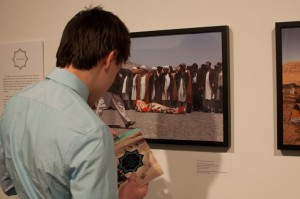By Joe Passantino
Correspondent
The College will continue to present “Art Amongst War: Visual Culture in Afghanistan,” an art gallery exhibition looking at Afghan culture, through Thursday, April 17.
The timing of the exhibition coincides with the 35-year anniversary of the Soviets invading Afghanistan in 1979, marking the beginning of a lengthy period of turmoil for the nation.

“When I look at it, it kind of makes me excited that this kind of exhibition can be done,” junior history and English double major Alexa Logush said. “The point of (‘Art Amongst War’) is that lives still go on, even amidst war.”
Logush, an art gallery assistant, noted that the large tapestry in its center was among her favorite pieces. Visitors are encouraged to rub their heads on the bottom of the tapestry, which, according to Logush, displays symbols representing “air.”
The exhibit is multi-faceted, featuring a wide range of different styles of artwork. In addition to the aforementioned tapestry, there are photographs with powerful imagery, such as a group of men praying at a mosque and pictogram-like “war rugs” depicting camels, cars and soldiers, among other war-related objects.
A particularly interesting feature of the exhibit is “Love Letters from Home” by Aman Mojadidi, featuring 79 security announcements and wardens’ messages to the United States military. These notices paint a picture of the regular danger these soldiers have experienced within a perennially toxic environment. Notably, the 79 messages span only from 2010 to 2011, begging the question of just how many would be needed to cover the entire duration of the war.
The same environment has also affected Afghans to a strong degree. This is clear in drawings from Moshtari Hilal’s ink-on-paper series, such as “Antique Mujahideen,” which appears to depict an Afghan with a rat in his eye and blood on his fingers. The man is clearly in pain and possibly even in a state of decay. This is perhaps a statement on how the man has become a simple victim of the chaos surrounding him.
The exhibit does, however, feature its share of relaxing imagery as well. This is highlighted by a hand-woven silk dress with silk-screened calligraphy and a photo of balloons in front of an old, worn-down building. The latter may symbolize hope for a seemingly hopeless nation.






